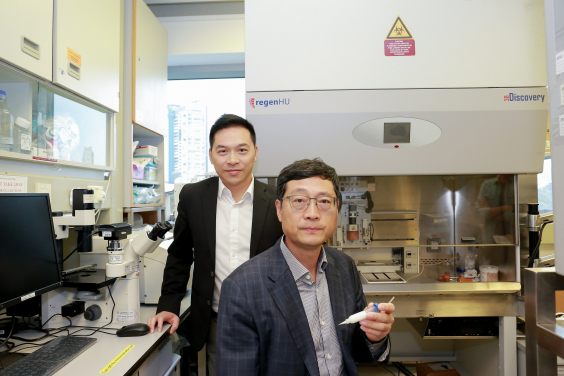Media
HKU research team receives national funding
to develop novel 3D bioprinting for human organs
17 May 2020
An HKUMed research team received funding from the National Key R&D Program of China’s Ministry of Science to advance bioprinting technology to include human tissues and organs.
With cutting-edge 3D bioprinting technology, the project aims to develop functionable human tissues and organs including full-thickness skin, cornea, bone, cartilage and major blood vessels. The team expects to launch the first human pre-clinical trial within five years.
The mid to long-term development target of the team is to translate their 3D bioprinting technique for the reconstruction of other organs and tissues, e.g. nephron, hepatic lobule, myocardial sphere, urethra, intervertebral disc, urinary bladder and ovary for transplantation surgery.
The research team led by Professor William Lu Weijia (Ng Chun-Man Professor in Orthopaedic Bioengineering) and Professor Kelvin Yeung Wai-Kwok from the Department of Orthopaedics & Traumatology has been awarded a total of RMB 27.44 million under China’s Ministry of Science’s (MoST) National Key R&D Program, which is the first national research grant directly “crossing the river” to support the R&D activities undertaken by Hong Kong researchers.
Set up in 2019, the research project “Functional reconstruction of human tissues and organs by precision addictive manufacturing technology” is the only national key R&D project being funded in Hong Kong and Macao. With matching funds from local governments and universities, the project cost adds up to over RMB 36 million.
HKU researchers will partner with other top-tier research institutions and enterprises in mainland China, such as Chinese Academy of Sciences (CAS) Shenzhen Institutes of Advanced Technology, Tianjin University, Novaprint Therapeutics Suzhou Company Limited (Novaprint), Peking University Beijing Jishuitan Hospital, and CAS Suzhou Institute of Biomedical Engineering and Technology etc. for all the pre-clinical issues, such as biosafety, effectiveness evaluation and human clinical trial. The team will also set up a clinical 3D bioprinting centre at The University of Hong Kong-Shenzhen Hospital.
The regeneration of human tissues and organs by 3D bioprinting is one of global strategic research developments, which can provide an effective solution to rescue functional loss or even failure of organs caused by aging, diseases and accidents.
In fact, the advancement of biomaterials in recent years has built up a significant foundation to support the reconstruction of tissues and organs. However, due to the complexity of such human tissues, how to use biomaterials to accurately print organs with complete functions that can function in the human body is the challenge facing the clinical application of biological 3D printing. The microenvironment required for tissues and organs must be printed to match functional reconstruction, including functional cell arrangement, distribution of blood vessels and nerves, etc., to guide the reconstruction and repair of 3D printed tissues and organs in vivo.
To realise the construction of complex tissue structure, the HKU team has earlier worked out a series of “bio-inks” together with the researchers from CAS Shenzhen Institutes of Advanced Technology and Tianjin University. The results suggested that the material properties of these “bio-inks” are resilient enough to provide sufficient mechanical stability regardless of the complexity of what tissue microenvironment presents in various organs.
The researchers have identified that the tissue microenvironment plays a critical role in tissue regeneration. Utilizing the newly invented multiaxial 3D bio-printing machine (OPUS) developed by Novaprint, the team plans to construct the functional scaffolds with better cell alignment, distribution of blood vessels and nerves, so as to regulate tissue regeneration as programmed precisely.
In a preliminary study of large-scale bone defect repair, the team has successfully fixed a 6mm bone defect in a goat model by using the newly invented bio-inks. Their next target is to assemble the vascular and neural network on the bone scaffolds with the use of new multi-axial and dynamic printing technology in order to achieve superior and faster bone regeneration in reality.
“3D bio-printing technology will bring hope to tissue and organ regeneration in the future. Due to the complex structures of human tissues and organs, the tissue regeneration can only be realised by integrated advanced printing technology with artificial intelligence control, high precision, and in situ multi-nozzle printing. I hope this project can help to advance our clinical practice and thereby improve the quality of life of patients”, said Professor William Lu.
“The HKUMed team comprises clinicians and scientists from different disciplines to lead the entire strategic plan of the project for human clinical trial. Hong Kong has an internationally renowned clinical trial management system and relevant medical technology. Hence, the team hopes to carry out human clinical trial locally first to benefit local patients with this medical advancement. Since the current funding is not sufficient to support the human clinical trial, we hope that the Hong Kong government or the University can make reference to matching schemes offered by other provincial governments or institutions to provide support to the team,” said Professor Kelvin Yeung.
Media enquiries:
Communication and Public Affairs Office, HKU
Ms Melanie Wan (Tel: 2859 2600 / Email: melwkwan@hku.hk)
Ms Rashida Suffiad (Tel: 2857 8555 / Email: rsuffiad@hku.hk)

